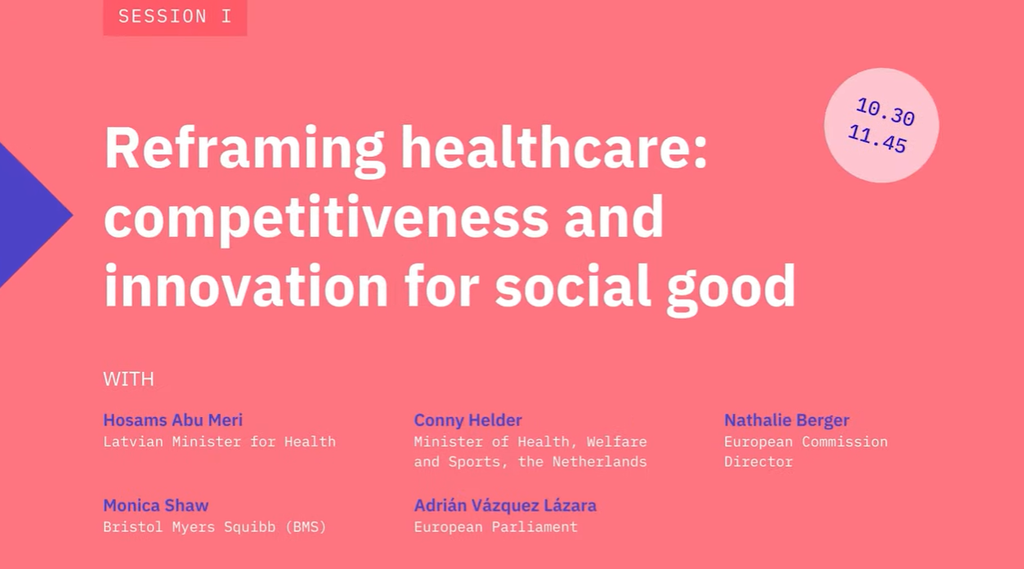Europe's moment: advancing clinical research and health innovation
Next event In person & online

- Area of Expertise
- Sustainable Livelihoods
Sustainable Livelihoods

President of the European Kidney Health Alliance (EKHA) and Chair of the European Chronic Disease Alliance (ECDA)
One in three adult Europeans suffers from chronic disease and more than 80% die from it. Early reports indicated that these patients, especially diabetics, cardiovascular, respiratory and cancer patients are at high risk during the COVID-19 pandemic. Next to these, Chronic Kidney Disease (CKD) patients recently appeared to be the most vulnerable to COVID-19 mortality. Chronic disease patients were more susceptible to infection, more frequently hospitalised, were more severely ill as illustrated by more admissions to intensive care units (ICUs) and had higher mortality rates than the general population. Of note, many of the survivors of severe COVID-19 will likely develop chronic complications such as pulmonary, cardiac and kidney failure, although often being healthy prior to infection.
Over the past months, healthcare systems experienced significant turmoil, to a large extent linked to the complex course of patients with chronic disease. These challenges also caused collateral damage to non-COVID-19 infected chronic disease patients, due to severe disruptions in care delivery, including postponement of ‘non-urgent’ interventions, and delayed care-seeking because of patients’ fear of infection or of placing additional burden on healthcare workers. The crisis generated shortages of medicines in several areas, ultimately worsening patients’ outcomes.
Healthcare systems were unprepared to face such an overwhelming patient influx with emergency care needs but quickly adapted, thanks to intersectoral solidarity; the intense growth of online inter-professional platforms; the formulation of recommendations and new protocols; and ingenious new practices including use of telemedicine. Molecular biology studies, epidemiologic databases, vaccine and drug development programs and therapeutic studies were implemented at incredible speed, already resulting in wide-ranging newly acquired knowledge and evidence-based therapeutic options.
Less than 10% of European investment in health is spent on prevention
Nevertheless, in view of upcoming infectious waves and in order to address underlying issues besetting European healthcare systems, more resilient and sustainable approaches are required.
The excellent work of the European Centre for Disease Prevention and Control (ECDC) should be extended to the area of chronic diseases, notably covering COVID-19 related-data. We need a pan-European database automatically embedding healthcare systems data in a comparable manner, allowing for rapid alert mechanisms and guidance both in the field of communicable and non-communicable diseases.
Currently, less than 10% of European investment in health is spent on prevention. Investment in prevention should be the cornerstone of building better healthcare systems, a recommendation that has been raised for decades by the scientific and healthcare community. COVID-19 is in this context a real eye-opener.
Dual pathways must be installed for healthcare systems
Timely awareness campaigns and new systems approaches should focus on difficult-to-reach and vulnerable populations, such as the youth, minorities, the socially-deprived and groups with low health literacy.
Rethinking diagnosis, rehabilitation and palliative care (in times of crisis and beyond) should be a priority, to boost integrated care approaches, uptake of digital solutions and systematic multi-disciplinary collaboration. COVID-19 has amplified the reality of unmet needs in these areas and the necessity of breaking silos between disciplines.
Dual pathways must be installed for healthcare systems to operate better in times of crisis, allowing routine health services to continue in parallel to services focused on crisis response.
They are the backbone of our healthcare systems
We need to better protect the physical and mental health of healthcare professionals; grow and continuously train the healthcare workforce. They are the backbone of our healthcare systems.
Improvements will only be possible if we monitor the uptake of guidance provided by international and European health advisory bodies on including chronic diseases in national public health plans; and the access to and continuity of health services for chronic diseases.
The example of Chronic Kidney Disease (CKD) strongly illustrates the overall sense of short-term and long-term urgency induced by the pandemic among the chronic disease population, as their percentage needing hospitalisation, and admission to the ICU exceeded that of all other chronic diseases. Mortality was exceedingly high especially for advanced CKD, kidney dialysis and kidney transplantation.
Kidney disease was largely neglected in the initial epidemiologic reports
However, there were also marked differences among dialysis patients, with a higher risk of infection for in-hospital dialysis as compared to home dialysis and transplantation. COVID-19 was also strongly connected with the second type of kidney disease, rapidly developing Acute Kidney Injury (AKI), a condition especially affecting previously healthy people but showing a mortality of up to 50% and a high risk of developing CKD in survivors.
In the margin of these dramatic evolutions, other problems occurred which unfortunately are illustrative of the insufficient awareness and understanding of kidney disease. Kidney disease was largely neglected in the initial epidemiologic reports. Peritoneal dialysis catheter positioning, which allows for dialysis at home was also postponed as non-urgent.
Moreover, the reshuffling of ICU focus caused a dramatic dip in transplant donation, increasing death rates on the waiting lists. The infectious risk of in-centre dialysis personnel also increased professional drop-out.
As kidney failure is an exclusion criterion in most drug and vaccination studies, the nephrology community was left in a therapeutic dark, forcing them into off-label use.
COVID-19 should be a wake-up call for governments and the EU
Next to a number of ad hoc measures that were similar to those for other chronic diseases, a long-term vision is needed in the kidney disease area.
CKD patients deserve specific attention because of the high therapeutic cost and the lack of therapeutic improvements. A policy shift towards home dialysis, more transplantation, prevention and medical innovation while registering kidney disease in epidemiological analyses from the early stages, will not only protect from infectious threats but will also have a societal impact by benefiting European health-economic status.
COVID-19 should be a wake-up call for governments and the EU to invest sustainably in healthcare systems, which will have to face the collateral damages of the crisis on population health, and above all in public health and disease prevention, to reverse the growing trend of chronic diseases and their dramatic impact on our societies and economies. Healthcare systems’ ‘rebuild’ plans and COVID-19 recovery strategies must be inclusive of chronic diseases so that systems of the next decade meet patients’ needs in a forward-looking way.
Next event In person & online

Past event In person & livestreamed

Past event In person

Past event In person & livestreamed





Stay informed
We use cookies and similar technologies to adjust your preferences, analyze traffic and measure the effectiveness of our campaigns. Learn more about our privacy policy.